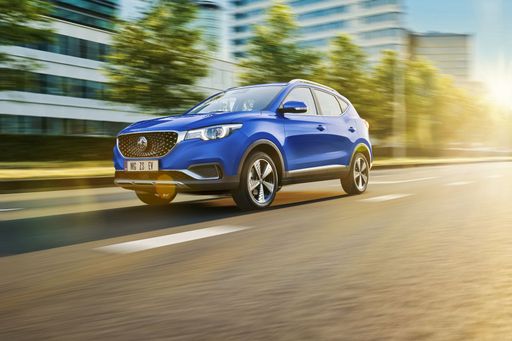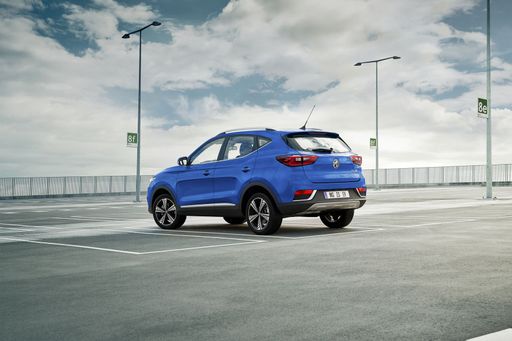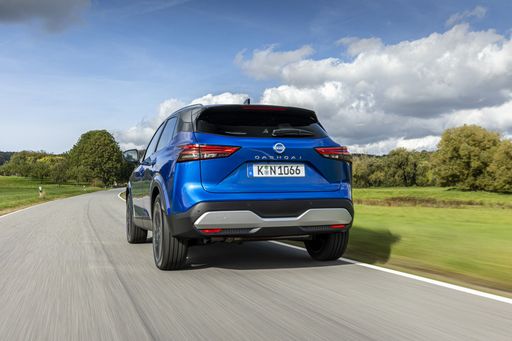When it comes to compact SUVs, the MG ZS and Nissan Qashqai are two popular options that offer a mix of performance, technology, and style. In this comparison, we’ll delve into the technical specifications and innovative features that set these two models apart.
MG ZS vs Nissan Qashqai – Which model is better for everyday use?
Two cars, one duel: MG ZS meets Nissan Qashqai.
Which one wins in performance, efficiency and value for money? Find out now!
Design and Dimensions
The MG ZS boasts a modern SUV design with a length ranging from 4323 mm to 4430 mm, a width of approximately 1809 mm, and a height of 1649 mm. In contrast, the Nissan Qashqai stands slightly taller at 1625 mm, with a length of 4425 mm and a width of 1835 mm. Both vehicles offer five-door configurations and the same seating capacity for five passengers, but the Qashqai provides a larger trunk capacity of 504 liters compared to the ZS's 448 liters.
Powertrains and Performance
When it comes to powertrains, the MG ZS offers an impressive range of engine options, including electric and full hybrid variants. The available power outputs range from 156 to 197 HP, with acceleration from 0 to 100 km/h in as little as 8.6 seconds. On the other hand, the Nissan Qashqai is powered by petrol MHEV and full hybrid engines, producing between 140 to 190 HP. Its acceleration can reach 100 km/h in as fast as 7.9 seconds, making it a sporty option in the compact SUV segment.
Fuel Efficiency
Efficiency is key in the SUV market, and here both models show strengths. The MG ZS offers fuel consumption rates between 5 to 5.1 L/100km for its hybrid variants, alongside impressive electric efficiency of around 17.3 to 17.8 kWh/100km for its electric model. The electric range also stands out, with a maximum range of 440 km. The Nissan Qashqai, however, offers competitive fuel consumption rates as well, at approximately 5.1 to 6.8 L/100km, depending on the variant chosen.
Innovative Features
Both SUVs are laden with technology, but they do cater to slightly different audiences. The MG ZS emphasizes a user-friendly infotainment system that includes a digital cockpit and multiple connectivity options. It is designed to enhance user interaction and integrate seamlessly with smartphones. The Nissan Qashqai, renowned for its advanced safety features, offers ProPILOT technology, which aids in both highway driving and navigation. The Qashqai also impresses with a cutting-edge infotainment experience, featuring a customizable digital dashboard and intuitive touchscreen controls.
Driving Experience and Comfort
In terms of driving dynamics, the MG ZS offers a comfortable ride with its front-wheel-drive configuration and adequate performance for city driving. It features a torquey engine lineup, delivering up to 280 Nm of torque, which allows for a pleasant and engaging driving experience. Meanwhile, the Nissan Qashqai includes both front-wheel and all-wheel-drive options, catering to a wider range of driving conditions and preferences. With up to 330 Nm of torque, the Qashqai provides robust performance, especially in hybrid variants.
Conclusion
In summary, both the MG ZS and Nissan Qashqai offer compelling packages in the compact SUV category. The ZS shines with its electric options and high-tech features, making it perfect for eco-conscious drivers, while the Qashqai stands out with its performance capabilities and advanced safety technologies. Ultimately, the choice between these two will depend on individual priorities, whether it be fuel efficiency, driving experience, or innovative features.
Here’s where it gets real: The technical differences in detail
Costs and Efficiency:
When it comes to price and running costs, the biggest differences usually appear. This is often where you see which car fits your budget better in the long run.
MG ZS has a significantly advantage in terms of price – it starts at 18000 £, while the Nissan Qashqai costs 29400 £. That’s a price difference of around 11400 £.
Fuel consumption also shows a difference: MG ZS manages with 5 L and is therefore barely noticeable more efficient than the Nissan Qashqai with 5.10 L. The difference is about 0.10 L per 100 km.
Engine and Performance:
Under the bonnet, it becomes clear which model is tuned for sportiness and which one takes the lead when you hit the accelerator.
When it comes to engine power, the MG ZS has a slight edge – offering 197 HP compared to 190 HP. That’s roughly 7 HP more horsepower.
In acceleration from 0 to 100 km/h, the Nissan Qashqai is a bit quicker – completing the sprint in 7.90 s, while the MG ZS takes 8.70 s. That’s about 0.80 s faster.
In terms of top speed, the Nissan Qashqai performs a bit better – reaching 206 km/h, while the MG ZS tops out at 179 km/h. The difference is around 27 km/h.
There’s also a difference in torque: Nissan Qashqai pulls clearly stronger with 330 Nm compared to 148 Nm. That’s about 182 Nm difference.
Space and Everyday Use:
Whether family car or daily driver – which one offers more room, flexibility and comfort?
Both vehicles offer seating for 5 people.
In curb weight, MG ZS is hardly perceptible lighter – 1330 kg compared to 1420 kg. The difference is around 90 kg.
In terms of boot space, the Nissan Qashqai offers a bit more room – 504 L compared to 443 L. That’s a difference of about 61 L.
In maximum load capacity, the MG ZS performs minimal better – up to 1457 L, which is about 10 L more than the Nissan Qashqai.
When it comes to payload, Nissan Qashqai slight takes the win – 520 kg compared to 470 kg. That’s a difference of about 50 kg.
Who comes out on top?
Overall, the Nissan Qashqai shows itself to be barely ahead and secures the title of DriveDuel Champion.
It convinces with the more balanced overall package and proves to be the more versatile choice for everyday use.
 @ Nissan Motor Corporation
@ Nissan Motor Corporation
Nissan Qashqai
MG ZS
The MG ZS presents itself as a practical and stylish compact SUV, ideal for those seeking comfort and functionality at an affordable price. With its spacious interior and modern design, it caters to both family and solo adventures, providing ample storage space and user-friendly technology. Additionally, the vehicle's efficient performance and refined drive make it a compelling choice for urban and motorway journeys alike.
details @ MG Motor / SAIC Motor Corporation
@ MG Motor / SAIC Motor Corporation
 @ MG Motor / SAIC Motor Corporation
@ MG Motor / SAIC Motor Corporation
 @ MG Motor / SAIC Motor Corporation
@ MG Motor / SAIC Motor Corporation
 @ MG Motor / SAIC Motor Corporation
@ MG Motor / SAIC Motor Corporation
 @ MG Motor / SAIC Motor Corporation
@ MG Motor / SAIC Motor Corporation
Nissan Qashqai
The Nissan Qashqai blends practical, family-friendly packaging with SUV styling that refuses to shout, making it a sensible and dependable choice for everyday life. It’s comfortable to live with, economical on the road, and neatly equipped enough to feel modern without ever feeling precious — perfect if you want crossover versatility without the drama.
details @ Nissan Motor Corporation
@ Nissan Motor Corporation
 @ Nissan Motor Corporation
@ Nissan Motor Corporation
 @ Nissan Motor Corporation
@ Nissan Motor Corporation
 @ Nissan Motor Corporation
@ Nissan Motor Corporation
 @ Nissan Motor Corporation
@ Nissan Motor Corporation
 @ MG Motor / SAIC Motor Corporation
@ MG Motor / SAIC Motor Corporation
|
 @ Nissan Motor Corporation
@ Nissan Motor Corporation
|
|
|
|
Costs and Consumption |
|
|---|---|
|
Price
18000 - 23100 £
|
Price
29400 - 42500 £
|
|
Consumption L/100km
5 - 6.5 L
|
Consumption L/100km
5.1 - 6.8 L
|
|
Consumption kWh/100km
-
|
Consumption kWh/100km
-
|
|
Electric Range
-
|
Electric Range
-
|
|
Battery Capacity
-
|
Battery Capacity
-
|
|
co2
113 - 145 g/km
|
co2
116 - 154 g/km
|
|
Fuel tank capacity
41 - 55 L
|
Fuel tank capacity
55 L
|
Dimensions and Body |
|
|---|---|
|
Body Type
SUV
|
Body Type
SUV
|
|
Seats
5
|
Seats
5
|
|
Doors
5
|
Doors
5
|
|
Curb weight
1330 - 1420 kg
|
Curb weight
1420 - 1665 kg
|
|
Trunk capacity
443 L
|
Trunk capacity
479 - 504 L
|
|
Length
4430 mm
|
Length
4425 mm
|
|
Width
1818 mm
|
Width
1835 mm
|
|
Height
1635 mm
|
Height
1625 mm
|
|
Max trunk capacity
1457 L
|
Max trunk capacity
1422 - 1447 L
|
|
Payload
375 - 470 kg
|
Payload
466 - 520 kg
|
Engine and Performance |
|
|---|---|
|
Engine Type
Full Hybrid, Petrol
|
Engine Type
Petrol MHEV, Full Hybrid
|
|
Transmission
Automatic, Manuel
|
Transmission
Manuel, Automatic
|
|
Transmission Detail
Automatic Gearbox, Manual Gearbox
|
Transmission Detail
Manual Gearbox, CVT, Reduction Gearbox
|
|
Drive Type
Front-Wheel Drive
|
Drive Type
Front-Wheel Drive, All-Wheel Drive
|
|
Power HP
116 - 197 HP
|
Power HP
140 - 190 HP
|
|
Acceleration 0-100km/h
8.7 - 12.5 s
|
Acceleration 0-100km/h
7.9 - 10.2 s
|
|
Max Speed
168 - 179 km/h
|
Max Speed
170 - 206 km/h
|
|
Torque
148 Nm
|
Torque
240 - 330 Nm
|
|
Number of Cylinders
4
|
Number of Cylinders
3 - 4
|
|
Power kW
85 - 145 kW
|
Power kW
103 - 140 kW
|
|
Engine capacity
1495 - 1498 cm3
|
Engine capacity
1332 - 1497 cm3
|
General |
|
|---|---|
|
Model Year
2024 - 2025
|
Model Year
2024
|
|
CO2 Efficiency Class
C, E
|
CO2 Efficiency Class
E, D
|
|
Brand
MG
|
Brand
Nissan
|
What drive types are available for the MG ZS?
The MG ZS is available as Front-Wheel Drive.
The prices and data displayed are estimates based on German list prices and may vary by country. This information is not legally binding.
